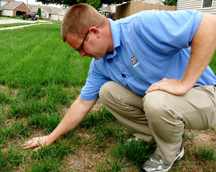Home lawn during drought: To water ... or not?
June 28, 2012
 |
|
Purdue University turf grass specialist Aaron Patton inspects a lawn that is partially green and partially brown, showing signs of drought stress. (Purdue Agricultural Communication photo/Tom Campbell) |
WEST LAFAYETTE, Ind. – Many homeowners wonder whether they should regularly water their dry lawns during a drought or essentially leave them alone. A Purdue Extension turfgrass specialist says each option has its pros and cons.
During a dry season, many lawns will show initial symptoms of drought stress, Aaron Patton said. As grass loses water, its leaves become less rigid and wilt; in this stage, grass stays flat after it is stepped on rather than "bouncing back."
The most telltale signs of drought stress, however, are the crunchy tan or brown leaves of grass that has entered dormancy; the plant is still alive, but the leaves dry up and die. This helps the plant conserve water and survive a drought.
Drought stress is most noticeable on slopes and lawns established on shallow or poor soil, Patton said.
"In order to keep your lawn green during hot and dry periods, at least 1 inch of water will need to be applied weekly," Patton said. "However, you can keep your lawn alive with far less water."
Homeowners can water regularly enough to avoid drought stress altogether, or they can let their lawn go dormant and water only occasionally to help it survive.
Some of the advantages and disadvantages of each option:
Watering to keep lawn green
"Water turf two to three times weekly - deeply, a good soaking, so you don't have to water daily," Patton said. Watering in the early-morning hours is most effective; watering in the evening could encourage disease or pests.
* Advantages: Turf will stay green, aesthetically pleasing and actively growing; ground remains soft so it can be used for recreation; deep soaking will foster deep roots, which will help plants better survive a prolonged drought.
* Disadvantages: Higher water bill for those with city water; some increased risk of turf disease.
Letting turf go dormant
"Once the lawn turns brown and goes dormant, we can't tell if a lawn is dying unless we water and wait to see the response," Patton said. "That is why we advise to water once every two weeks with one-half inch of water once the turf goes dormant to keep plant crowns hydrated during drought. This amount of water will not green up the turf, but it will increase long-term survival during long dry spells."
* Advantages: Avoid irrigation costs; most turf species are drought-tolerant and will survive typical Indiana droughts.
* Disadvantages: Difficult to tell when turf is getting too dry and needs water to stay alive; lawn is brown and has poor aesthetics; hard soil makes turf less usable for recreation; turf is more susceptible to injury and will not recover until rain returns; some thinning and turf death can occur if there is no rain for 4-6 weeks and no irrigation is applied.
Patton emphasized that when lawns are dry, it is important to stay off them. Mowers and other heavy equipment can cause substantial damage to vulnerable, stressed grass. Once rains return, the turf will begin to recover and grow new leaves within two weeks.
For more information about keeping lawns healthy during the drought, visit http://purdueturftips.blogspot.com/
Writer: Jessica Merzdorf, 765-494-8402, jmerzdor@purdue.edu
Source: Aaron Patton, 765-494-9737, ajpatton@purdue.edu
Ag Communications: (765) 494-2722;
Keith Robinson, robins89@purdue.edu
Agriculture News Page

